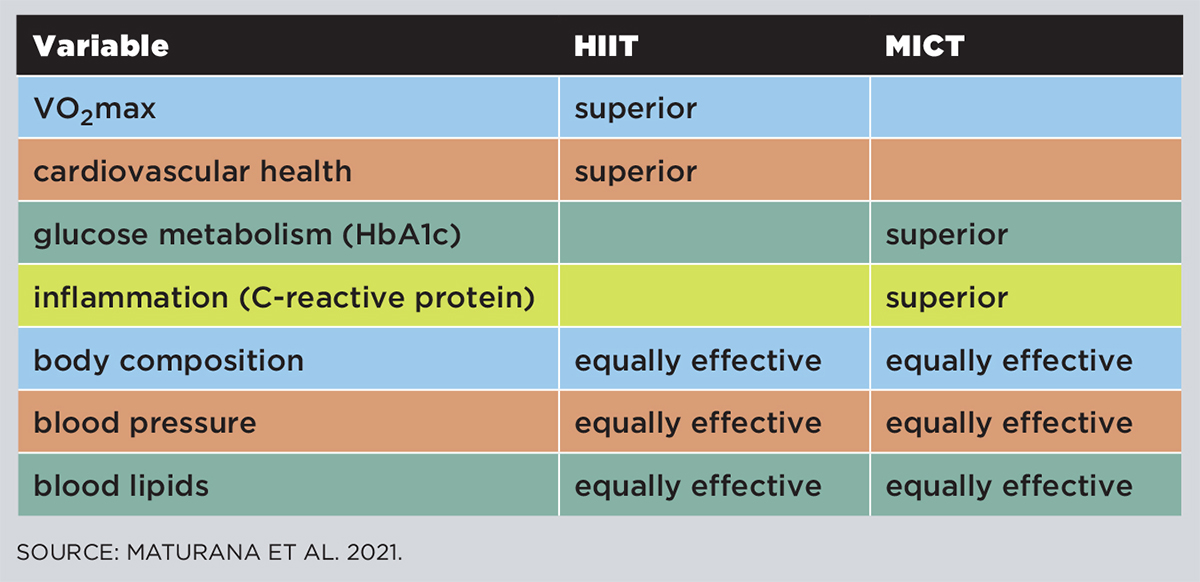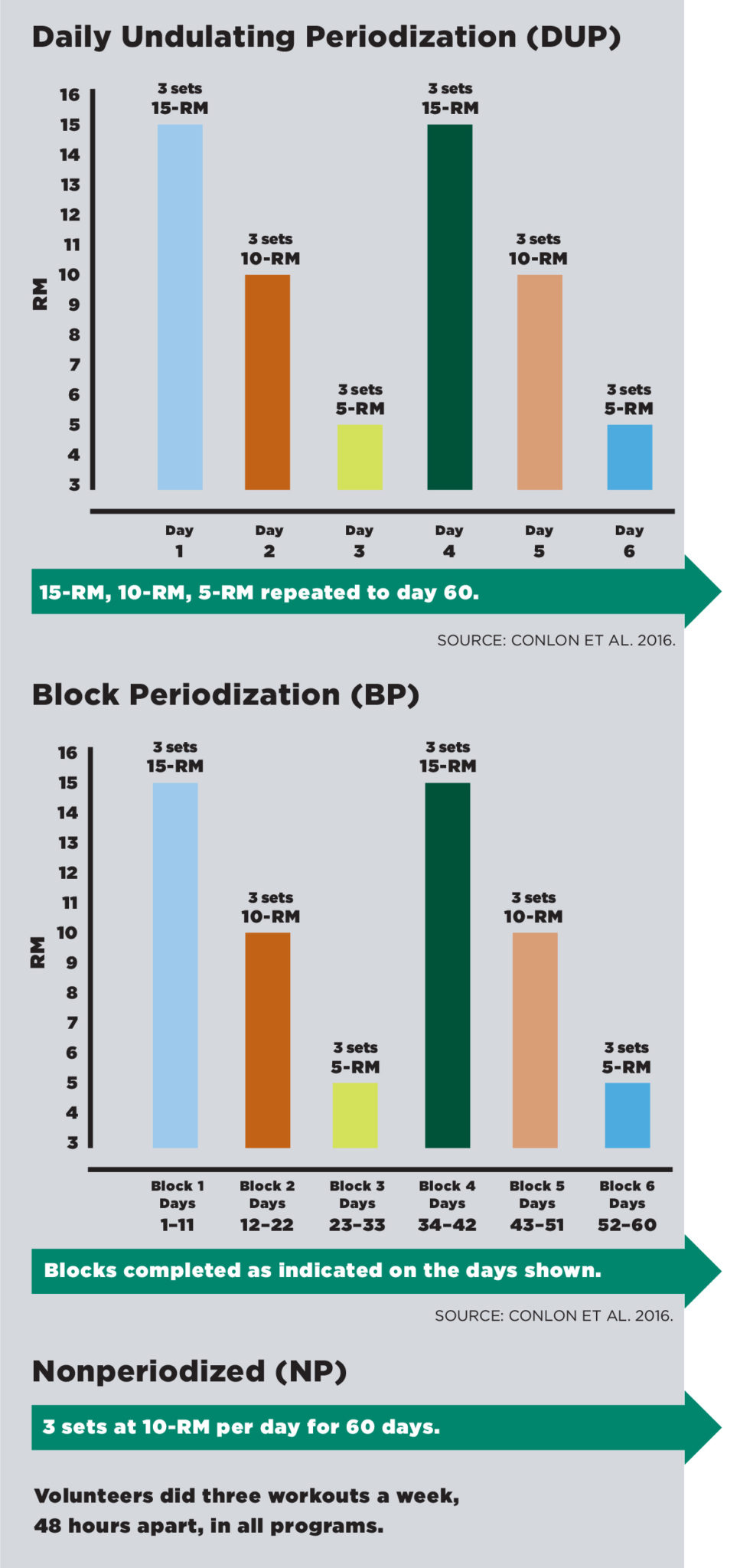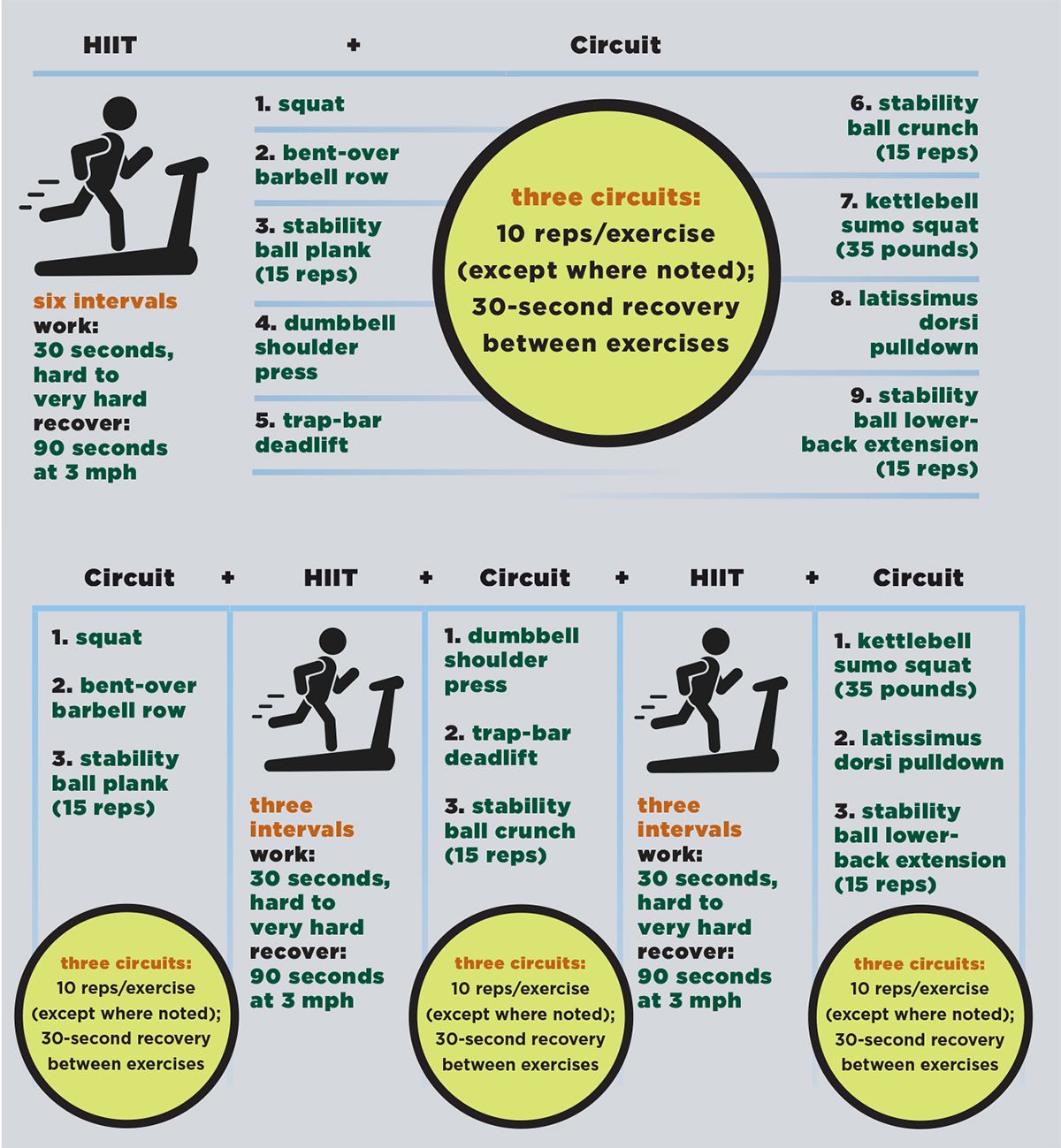Great Workouts From Around the World
Travel the globe to find evidence-based training programs that will transport your clients to greater success.

Every exercise enthusiast would be gratified to find a workout that provided cardiovascular benefits, musculoskeletal gains, psychological advances, and improvements in range of motion, body composition and overall health. Most workouts are laser-focused on one or two of these outcomes, and researchers around the world have mapped out some impressive work studying the great workouts and program designs with the most effective results.
The “great workouts” highlighted here were all tested in a peer-reviewed published research study, in which outcome data showed they excelled in at least one (or more!) of the key areas noted above.
In looking more closely at these programs, this article will discuss (1) workouts that combat sedentary behavior, (2) HIIT versus moderate-intensity continuous exercise for improving cardiometabolic risk factors in adults and children, (3) resistance training for older adults, and (4) programs combining HIIT and circuit training in one workout. Think of this overview as a passport to taking your evidence-based practices to the next level.
Note: It is important and gratifying to report that every study had all participants complete a safe, appropriate, individualized warmup and cooldown for each workout. Please do the same with your clients.
Australia: Great Workouts to Combat Sedentary Behavior
The hazards of prolonged sitting were first identified in the early 1950s when Morris et al. (1953) identified a significantly higher rate of heart attacks in London bus drivers (who primarily sit on the job) as compared with bus conductors (who are physically active). Since this early research, exercise scientists have primarily studied the association between moderate- to vigorous-intensity exercise and health. However, in the last 10 years, researchers have revisited the effects of physical activity versus sedentary behavior (i.e., sitting).
In American society, sedentary behavior dominates our lifestyles: watching television, computer use for work and pleasure, driving/commuting, reading, dining, and more. Raichlen et al. (2020) highlight research showing that sitting requires no muscle activity. This inactivity reduces local muscle metabolism, causing potentially detrimental effects on blood flow, endothelial health (health of the thin membrane lining the inside of blood vessels), fat and carbohydrate metabolism, and regulation of inflammation. The researchers note that the mechanisms for these inactivity-induced ill health effects remain unclear.
In a recent systematic review and meta-analysis, Saunders et al. (2018) conclude that prolonged sitting, common in the workplace, leads to elevated levels of post-meal blood insulin and glucose. Dunstan et al. (2012) synthesize research indicating that elevated post-meal glucose is associated with the development of atherosclerosis and cardiovascular disease.
In their systematic review, Saunders and colleagues conclude that breaking up sitting time with light- or moderate-intensity physical activity will result in lower post-meal glucose and insulin levels. Knowing which intensity (light or moderate) is more effective for breaking up periods of prolonged workplace sitting had been an unanswered question, and Dunstan and colleagues chose to explore this question in their research.
See also: 5 Resistance Training Workouts That Improve VO2max
The Study: Dunstan et al. 2012
Nineteen inactive, overweight/obese (BMI >25; ages 45–65 years) women and men volunteers with elevated diabetes risk completed three randomized visits to the laboratory. On each visit, participants provided blood samples after an overnight fast. The volunteers then began one of three different 5-hour blocks of sitting. At the 2-hour point in each trial, subjects consumed a standardized drink consisting of 75 grams of carbohydrate and 50 g of fat. They were given no other food during the 5-hour block.
The sitting trials, randomized and scheduled 6 days apart, were as follows:
- 5 hours of uninterrupted sitting (except to go to the restroom)
- sitting + light-intensity walking During the 5-hour time block, participants got up every 20 minutes and walked for 2 minutes on a treadmill at 2 miles per hour (rating of perceived exertion was 8 on the 6–20 RPE scale).
- sitting + moderate-intensity walk-ing During the 5-hour time block, participants got up every 20 minutes and walked for 2 minutes on a treadmill at 3.6–4.0 mph (RPE of 12 on the 6–20 RPE scale).
All participants did various office work activities during the 5-hour blocks of time.
Results
Both sitting + light intensity and sitting + moderate intensity significantly and equally lowered blood glucose and insulin levels as compared with uninterrupted sitting.
Fit Pro Takeaway
Encourage all clients who have sedentary occupations or lifestyles to get up and move for 2 minutes after every 20 minutes of sitting. Intensity can be light or moderate for optimal health benefits.
To encourage all chair-bound (working or lifestyle) clients to remember to move, consider using a catchy phrase—for example, “For every 20 get your 2,” meaning for every 20 minutes of seated behavior get 2 minutes of movement (light or moderate intensity). See “4 2-Minute Walking Breaks” and “4 ‘No-Sweat’ Resistance-Exercise Circuit Breaks,” below, for eight sample physical activity breaks that you can share with clients to thwart sedentary behavior.
Germany: HIIT Versus Moderate-Intensity Continuous Exercise for Improving Cardiometabolic Risk Factors
Research on the health-enhancing benefits of great workouts with cardiovascular exercise has delivered convincing outcomes for both heart health and longevity in both healthy and diseased populations (Maturana et al. 2021). Maturana and colleagues explain that the aerobic exercise–induced release of myokines (small proteins produced and secreted by contracting muscles) into the circulation play an essential role in cardiometabolic health, improving glucose metabolism and helping to protect against cardiovascular disease. They add that different levels of exercise are needed to induce meaningful clinical benefits in key outcomes affecting the circulatory system, such as general fitness, cardiovascular function and vascular health.
Moderate-intensity continuous training (MICT) is commonly classified as prolonged endurance training performed at moderate intensity. Conversely, Maturana and colleagues submit that high-intensity interval exercise is often described as (a) high-intensity interval training (HIIT), in which bursts of higher-intensity exercise (>80% of maximal oxygen uptake or >85% of maximal heart rate) alternate with lower-intensity bouts of active recovery; and (b) sprint interval training (SIT), similar in design to HIIT, but with high-intensity exercise bursts performed for <30 seconds in an all-out manner, alternating with lower-intensity bouts of active recovery.
See also: HIIT Training for Fast, Efficient Fat Loss
The Study: Maturana et al. 2021
Because there’s much debate over the effectiveness of HIIT versus MICT for improving several variables of cardiometabolic health and reducing cardiovascular disease risk, the purpose of the Maturana et al. meta-analysis investigation was to specifically compare evidence-based outcomes of HIIT versus MICT on seven variables: (1) physical fitness (via maximal aerobic capacity); (2) cardiovascular health (endothelial function); (3) body composition (body mass index, body mass and body fat); (4) blood pressure (systolic and diastolic blood pressure); (5) blood lipids (HDL, LDL, triglycerides and total cholesterol); (6) inflammation (as measured by C-reactive protein); and (7) insulin and glucose metabolism (fasting glucose, fasting insulin, HbA1c and insulin resistance).
Results
The meta-analysis incorporated 55 studies from 1976 to 2020 that included 775 HIIT participants (476 men, 222 women and 77 gender not reported) and 754 MICT participants (468 men, 242 women and 44 gender not reported), all ages 20–64.
It’s interesting that HIIT, specifically, showed a higher effect than MICT in improving VO2max, particularly among older participants. Maturana et al. explain that HIIT programs induce a higher shear stress on blood vessels. This promotes an increase in nitric oxide release (through activation of endothelial nitric oxide synthase). The overall result is improved vasodilation, which ensures more efficient delivery of oxygen to working muscle.
For body composition, the data suggest that long-term changes are similar with HIIT and MICT, but all successful programs must have an accompanying nutritional component. Similarly, for blood pressure reduction in persons with high blood pressure, both HIIT and MICT are great workouts and equally effective.
Another important note from Maturana et al. is that MICT and HIIT have been shown to effectively and independently improve HDL-C, the healthy cholesterol. In some cases, HIIT, being higher intensity, may trigger more fat oxidation. This can induce a greater reduction in LDL-C, the lousy cholesterol, either by increasing clearance of blood lipids or by reducing secretion of LDL-C by the liver. These physiological data suggest that SIT (due to its all-out intensity level) may be a viable program for lowering LDL-C.
C-reactive protein (CRP) is a protein made by the liver. It is sent into the bloodstream in response to inflammation, which can be caused by infection, trauma, injury, ill heart health or cancer.
Elevated CRP is associated with increased risk of heart attack. The meta-analysis revealed that MICT controlled levels of CRP more effectively than HIIT.
MICT also showed superior improvements in long-term glycemic control (HbA1c), a precursor to type 2 diabetes. However, no differences were seen between HIIT and MICT in the improvements in fasting insulin and fasting glucose levels.
Fit Pro Takeaway
Maturana and colleagues provide a very clear and compelling takeaway for fitness professionals. The authors propose that individualized exercise training programs aimed at improving overall health should incorporate both HIIT and MICT to maximize cardiometabolic benefits for the client.
See “Evidence-Based HIIT and MICT Workouts to Improve Vascular Function” and “Evidence-Based HIIT and MICT Workouts to Improve Health in Children,” below, for great workouts to sample.
Australia: Resistance Training for Older Adults
Many fitness pros train older women and men who want to maintain and/or increase skeletal muscle mass and prevent the progressive loss of muscle that occurs with aging (i.e., sarcopenia). Data affirm that total muscle mass is lost at a rate of approximately 1%–2% per year after age 50 (Conlon et al. 2016).
Conlon and colleagues emphasize that this progressive decline will have a deleterious influence on neuromuscular function, leading to decreases in maximal strength that have been estimated at 2.5%–5% per year. Woefully, these drops are major factors in raising the risk of falls and physical disability in older adults. The only intervention that can prevent this cascade of skeletal muscle shortfalls is consistent adherence to resistance training. Conlon et al. show that progressive resistance training programs increase the functional independence of older women and men, improving their ability to engage in activities of daily living.
For trained and untrained young adults, periodized training programs have proved to be superior to nonperiodized strategies (Mang, St. Germain & Kravitz 2020). However, it is not clear what type of organized resistance training program is best for counteracting the negative effects of aging in older adults.
See also: Resistance Training for Older Adults: New NSCA Position Stand
The Study: Conlon et al. 2016
From Conlon and team’s original recruitment efforts, 33 untrained volunteers (17 women, 16 men; average age 71) met all study requirements and completed the 22-week investigation. Participants were randomly assigned to daily undulating periodization (DUP), block periodization (BP) or nonperiodized (NP) training (see right). Machines were used for all resistance training exercises (participants were familiarized with the equipment before the study began).
Volunteers did three workouts a week, 48 hours apart. Instructors with bachelor’s degrees in exercise science supervised the sessions to ensure proper technique. The DUP, BP and NP groups did the same upper- and lower-body exercises throughout the study (bench press, seated leg press, latissimus dorsi pulldown, seated leg curl, leg extension and seated row). Participants were instructed to perform the concentric exercise with maximal velocity and the eccentric (lowering) movement with a 2-second cadence. All sets were performed to momentary concentric failure, described as an inability to complete the muscle-shortening phase of a repetition because of fatigue. There was a 1.5- to 2-minute recovery period between consecutive sets of an exercise.
Throughout the study, repetition training zones employed were 15-repetition maximum (15-RM) for strength/endurance, 10-RM for hypertrophy and 5-RM for strength. Importantly, total repetitions were equalized among all training groups—as was total volume load, calculated as number of sets 3 number of repetitions 3 weight lifted.
After each workout, participants consumed a 30-gram liquid whey-protein supplement with 24.1 g of protein, 1.7 g of total fat, 1.1 g of saturated fat and 1.4 g of total carbohydrate.
Results
Overall, the DUP, BP and NP groups equally showed the following excellent increases: bench press (30.3%), leg press (47.1%), repeated chair rise (9.9%), stair climbing (20.7%), muscle mass (6.7%), balance confidence (2.3%), muscle mass (6.7%) and HDL cholesterol (5.9%). All groups also showed these healthy decreases: percent body fat (-11.9%) and systolic blood pressure (mean decrease for all groups was 3.2%).
Critically, the researchers were meticulous in equalizing the overall training volume and intensity across the three groups. With all variables measured, DUP, BP and NP led to similar rates of improvement. It is meaningful to note that this is one of very few studies that has ever compared the effects of periodized and nonperiodized training in older women and men. Both strategies worked quite effectively.
Fit Pro Takeaway
With older clients, both women and men, periodized and nonperiodized training programs appear to be equally and highly effective for a number of physiological outcomes. Conlon et al. recommend replicating this investigation over a 1-year timespan to determine whether a real-life, long-term advantage exists between the programs.
The authors warn that some participants showed signs of overtraining, because all sets were performed to momentary muscular fatigue. The researchers encourage using a safety-first strategy with this population and not always pushing clients to momentary muscular fatigue. That is a very meaningful message to fit pros working with any population of women and men.
United States: Combining HIIT and Circuit Training in One Workout

Circuit training has evolved to be a time-efficient program for achieving musculoskeletal improvements.
Identifying great workouts and exercise programs that integrate both cardiovascular exercise and resistance training has been a growing priority for trainers seeking to optimize the limited time clients have for exercise. As noted in Conlon et al. (2016), time is a major barrier to starting and/or maintaining a regular exercise program.
Uniquely, HIIT has emerged as a most impressive, time-efficient form of aerobic exercise. Likewise, circuit weight training—in which participants move sequentially from one exercise station to the next, with minimal rest between stations—has evolved to be an efficacious, time-efficient program for achieving musculoskeletal improvements.
Nunez and colleagues investigated two creative combinations of these highly popular training programs. As the supervising professor of the Nunez investigation, I can share the “back story” to the study’s development.
First, Nunez considered hundreds of published HIIT studies. He and his team selected the actual HIIT protocol from the results of another study for which he was a research team member (Moriarty 2017). Next, after completing a comprehensive review of literature on circuit training, the team developed the circuit exercises and protocols for the study. The strategy Nunez followed in developing his investigation is referred to as the “scientific method” in research. It involves thoughtful reasoning based on research, followed by the development and testing of a new hypothesis (in this case, two different workout programs) with a study.
See also: Neuromuscular Power Circuits
The Study: Nunez et al. 2020
Fourteen physically active male volunteers (average age 26) performed two completely different combination programs of HIIT and circuit training (see “HIIT Plus Circuit (H+C)” and “Circuit Integrated With HIIT (C3H3),” page 43), separated by at least 72 hours.
HIIT Plus Circuit (H+C) involved six bouts of HIIT followed by three circuits of nine exercises. Circuit Integrated With HIIT (C3H3) consisted of multiple three-exercise circuits (each repeated three times) integrated with three bouts of HIIT. Both of the HIIT and circuit training programs were precisely equated for time (43.25 minutes) and total work, meaning participants did the same exercises with the same load, the same amount of rest and the same number of HIIT intervals (at the same intensity). Thus, the only difference in the two programs was the sequence.
All externally loaded circuit exercises were performed for 10 repetitions at 50% of 1-RM for 30 seconds, followed by a 30-second recovery period. These exercises included the Smith machine back squat, bent-over barbell row, trap-bar deadlift, dumbbell shoulder press and latissimus dorsi pulldown.
Except where noted, other exercises were performed for 15 repetitions. Three of the circuit stations were body-weight exercises, meaning no external load was added; these exercises were the stability ball (SB) crunch, SB plank and SB lower-back extension. One exercise, the kettlebell sumo squat, was performed with a 35-pound kettlebell (10 repetitions) for every participant.
All HIIT intervals were performed on a treadmill (set at a 3% grade) in a 1:3 format (30 seconds of work at near-maximal speed with hard to very hard intensity, followed by a 90-second recovery walk at 3 mph).
The major question of this investigation was whether program sequence (H+C versus C3H3) would result in any differences in exercise heart rate, oxygen consumption, blood lactate response (immediately post-, 5 minutes post-, 10 minutes post- and 20 minutes post-exercise), RPE, excess post-exercise oxygen consumption (EPOC, for 20 minutes post-exercise), and enjoyment.
Results
Both programs yielded highly impressive energy expenditure outcomes, with H+C burning 434 kilocalories and C3H3 expending 419 kcal. EPOC was also slightly higher for H+C (61 kcal) than for C3H3 (56 kcal). Both programs provided a potent cardiovascular stimulus, eliciting an average heart rate response of 78% of heart rate max and an average oxygen consumption response of 57% of VO2reserve. Blood lactate results indicated that H+C levels were higher immediately post-, 5 minutes post-, 10 minutes post-
and 20 minutes post-exercise.
Nunez et al. explain that C3H3 likely cleared blood lactate more effectively. This suggests that the C3H3 design causes less metabolic stress and may therfore be preferable for entry level clients.
Fit Pro Takeaway
This is the first study of its kind to methodically compare two combinations of HIIT and circuit training combined in one workout. On average, both programs yielded an energy expenditure of 10 kcal per minute, indicating that either would be an excellent exercise intervention in a weight management program. Additionally, the heart rate and VO2 responses suggest that both programs also provide a first-rate cardiovascular stimulus for improving aerobic fitness and promoting kcal expenditure.
Each of the programs was rated enjoyable and gratifying by the participants. It would be great if this study was replicated in a young adult female population and if the designs were modified appropriately for older females and males (and then investigated) to best determine evidence-based applications for those populations.
Final Takeaway Message
In total, the take-homes from this review are eight physical activity breaks to combat sedentary behavior; two HIIT and two MICT workouts that improve cardiovascular health in adults and children; block periodization, nonperiodized and daily undulating periodization programs for older adults; and H+C and C3H3 workouts that can be readily modified for all fitness levels. Enjoy sharing these “Great Workouts From Around the World” with your clients.
4 Options for 2-Minute Walking Breaks
- 30/30 walking: 30 seconds of brisk walking, then a comfortable 30-second relief walk; 2 repetitions for 2 minutes of activity.
- 10/10 walking: 10 seconds of brisk walking, then a comfortable 10-second relief walk; 6 repetitions for 2 minutes of activity.
- Variable-speed walking: 2 minutes of walking with random changes to speed and distance. (Ask clients to set an app timer for 2 minutes. Then, encourage them to randomly change their speed and distance with this straightforward suggestion: “Walk with random speed changes of slow, medium and fast for 2 minutes.”)
- 60/60 walking: 60 seconds of brisk walking, then a comfortable 60-second recovery walk; once only for 2 minutes of activity.
4 Options for “No-Sweat” Resistance-Exercise Circuit Breaks
Have clients do 10 repetitions of each movement listed below. Begin with one circuit and progress to two when clients are ready for a little more challenge.
- Circuit A: 10 sit-to-stands, 20 knee raises, 10 wall pushups
- Circuit B: 20 knee raises, 10 wall pushups, 10 sit-to-stands
- Circuit C: 10 wall pushups, 10 side-to-sides (both legs), 20 knee raises
- Circuit D: 10 side-to-sides (both legs), 20 knee raises, 10 sit-to-stands
Notes:
For knee raises, try alternating the knees (i.e., total of 20 alternating knee raise).
For sit-to-stands, teach clients using an immobile chair and discard the chair if/when they are comfortable doing partial squats.
For side-to-sides, have clients take a step to the side, partially bending the stepping leg, then push off the bent leg and return to standing (repeat with other leg).
For wall pushups, position clients about 2 feet from the wall, standing, with arms extended. Cue them to bend the elbows, lean the body to the wall until the nose almost touches and then push back to the starting position.
Evidence-Based HIIT and MICT Workouts to Improve Vascular Function
In a systematic review and meta-analysis, Ramos et al. (2015) quantify the benefits of HIIT and MICT for vascular function.
The researchers submit that vascular dysfunction is a precursor to atherosclerotic plaque buildup, appreciably increasing a person’s susceptibility to cardiovascular events such as myocardial infarction or stroke.
Importantly, Ramos and colleagues note that exercise training (using a safe mode of exercise) has proved to be a practical, therapeutic strategy for boosting vascular function in various clinical populations. The Ramos review suggests that workouts designed to increase vascular function
with MICT should last 30–50 minutes and have an intensity of 50%–70% of HRmax (light to moderately hard on the RPE scale).
Studies show that positive changes in vascular function are observed when this workout is completed three times a week for 12–16 weeks. Importantly, fit pros should individualize MICT and HIIT workout designs, tailoring them to the fitness levels of their clients.
This review found that the HIIT workout (below) was highly effective and was most commonly used in research to improve vascular function.
Intervals:
a 4-minute work interval at 85%–95% of HRmax/peak (very hard on the RPE scale)
a 3-minute active recovery interval at 50%–70% of HRmax/peak (light to moderately hard on the RPE scale)
- Repeat the work/recovery interval sequence up to four times per session.
- Complete the workout up to three times a week.
Note: Always include an individualized warmup and cooldown for both HIIT and MICT workouts.
Evidence-Based HIIT and MICT Workouts to Improve Health in Children
Thirty obese, physically inactive girls and boys (ages 8–12) were randomly assigned to either HIIT or MICT in a 12-week study (two workouts per week on nonconsecutive days) (Corte de Arujo et al. 2012). The MICT group progressed
from 30- to 60-minute continuous exercise sessions at 80%
of peak heart rate.
The HIIT group progressed from 3 to 6 sets of a 60-second sprint at 100% of peak speed, alternating with a 3-minute active-recovery period
at 50% of peak speed.
Overall, both groups showed significant and equally impressive improvements in aerobic fitness, insulin sensitivity and BMI.
References
Conlon, J.A., et al. 2016. Periodization strategies in older adults: Impact on physical function and health. Medicine & Science in Sports & Exercise, 48 (12), 2426–36.
Corte de Arujo, A.C., et al. 2012. Similar health benefits of endurance and high-intensity interval training in obese children. PLOS ONE 7 (8), e42747.
Dunstan, D.W., et al. 2012. Breaking up prolonged sitting reduces postprandial glucose and insulin responses. Diabetes Care, 35 (5), 976–83.
Mang, Z., St. Germain, J., & Kravitz, L. 2020. Periodization for maximizing hypertrophy. Fitness Journal, 17 (3), 18–27.
Maturana, F.M., et al. 2021. Effectiveness of HIIE versus MICT in improving cardiometabolic risk factors in health and disease: A meta-analysis. Medicine & Science in Sports & Exercise, 53 (3), 559–73.
Moriarty, T. 2017. The physiology of sprint interval training. IDEA Fitness Journal. Accessed Mar. 23, 2021: www.ideafit.com/personal-training/the-physiology-of-sprint-interval-training/.
Morris, J.N., et al. 1953. Coronary heart-disease and physical activity of work. The Lancet, 262 (6795), 1053–57.
Nunez, T.P., et al. 2020. Metabolic effects of two high-intensity circuit training protocols: Does sequence matter? Journal of Exercise Science & Fitness, 18, 14–20.
Raichlen, D.A., et al. 2020. Sitting, squatting, and the evolutionary biology of human inactivity. Proceedings of the National Academy of Sciences, 117 (13), 7115–21.
Ramos, J.S., et al. 2015.The impact of high-intensity interval training versus moderate-intensity continuous training on vascular function: A systematic review and meta-analysis. Sports Medicine, 45 (952), 679–92.
Saunders, T.J., et al. 2018. The acute metabolic and vascular impact of interrupting prolonged sitting: A systematic review and meta-analysis. Sports Medicine, 48 (10), 2347–66.
Len Kravitz, PhD
Len Kravitz, PhD is a professor and program coordinator of exercise science at the University of New Mexico where he recently received the Presidential Award of Distinction and the Outstanding Teacher of the Year award. In addition to being a 2016 inductee into the National Fitness Hall of Fame, Dr. Kravitz was awarded the Fitness Educator of the Year by the American Council on Exercise. Just recently, ACSM honored him with writing the 'Paper of the Year' for the ACSM Health and Fitness Journal.








